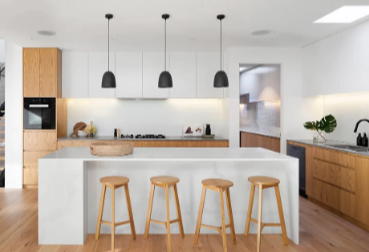Eco-Friendly Materials for Modern Kitchen Cabinet

As sustainability becomes increasingly important in home design, many homeowners are seeking eco-friendly materials for their kitchen renovations. Kitchen cabinets, a major component of any kitchen, can be crafted from a variety of sustainable materials that are both stylish and environmentally responsible. Choosing eco-friendly options not only helps reduce your environmental footprint but also ensures a healthier indoor environment. In this article, we will explore some of the best eco-friendly materials for modern kitchen cabinets.
1. Bamboo
Bamboo is one of the most popular eco-friendly materials for kitchen cabinets in Toronto. Technically a grass, bamboo is incredibly fast-growing, making it a highly renewable resource. It can be harvested in just 3 to 5 years, unlike traditional hardwoods that can take decades to mature.
Bamboo is durable, strong, and resistant to moisture, making it an excellent choice for kitchen cabinetry. It also has a unique, contemporary appearance with its fine grain and natural finish, which can add a touch of elegance to your kitchen. Additionally, bamboo is naturally anti-bacterial, which is a great feature for kitchen spaces.
2. Recycled Wood
Using recycled or reclaimed wood for kitchen cabinets is a fantastic way to incorporate eco-friendly materials into your kitchen. Reclaimed wood is sourced from old buildings, barns, and other structures that are no longer in use. By repurposing this wood, you are helping to reduce the demand for new timber and prevent valuable resources from ending up in landfills.
Reclaimed wood offers a rustic, character-rich aesthetic that can add warmth and charm to your kitchen. Each piece of wood has its own history, with unique grain patterns, knots, and imperfections that tell a story. It’s also worth noting that reclaimed wood is often harder and more durable than newly harvested wood, having aged and hardened over time.
3. Formaldehyde-Free Plywood
Plywood is a common material used in kitchen cabinets, but traditional plywood often contains formaldehyde, a toxic chemical that can off-gas into your home over time. Fortunately, there are eco-friendly alternatives, such as formaldehyde-free plywood, which use safer, non-toxic adhesives.
Formaldehyde-free plywood is made from thin layers of wood veneer that are bonded together with environmentally friendly glues. It’s a versatile material that can be used for both the cabinet structure and the doors. When choosing formaldehyde-free plywood, look for products that are certified by organizations like the Forest Stewardship Council (FSC), which ensures that the wood is sourced from responsibly managed forests.
4. Recycled Metal
For a modern and industrial look, consider using recycled metal for your kitchen cabinets. Recycled steel or aluminum cabinets are not only stylish but also incredibly durable and long-lasting. These materials are resistant to moisture, pests, and fire, making them a practical choice for kitchens.
Recycled metal cabinets can be customized with different finishes, such as brushed, polished, or powder-coated, to achieve the desired look. While metal cabinets are often associated with a sleek, industrial design, they can also be softened with the addition of wood or glass accents. By choosing recycled metal, you are reducing the demand for newly mined metals and contributing to a more sustainable environment.
5. Sustainable Wood Veneers
Wood veneers are thin slices of wood that are applied to a substrate material, such as plywood or MDF, to give the appearance of solid wood. When sourced sustainably, wood veneers can be an eco-friendly option for kitchen cabinets. Look for veneers that come from FSC-certified forests, which ensures that the wood is harvested responsibly and with minimal environmental impact.
Sustainable wood veneers offer the beauty and warmth of natural wood without the need for large quantities of solid wood. They are available in a wide range of wood species, colors, and grain patterns, allowing you to achieve the look you want while being mindful of your environmental impact.
6. Recycled Plastic and Composite Materials
Recycled plastic and composite materials are increasingly being used for eco-friendly kitchen cabinets. These materials are made from post-consumer recycled plastics, such as bottles and containers, which are processed and molded into durable panels for cabinetry.
Recycled plastic cabinets are resistant to moisture, stains, and pests, making them a low-maintenance option for kitchens. They are also available in a variety of colors and finishes, allowing you to create a custom look that suits your style. By choosing recycled plastic cabinets, you are helping to reduce plastic waste and support the circular economy.
Read more: A Beginner’s Guide to Share Market Investment
7. Wheatboard and Strawboard
Wheatboard and strawboard are innovative, eco-friendly alternatives to traditional particleboard and MDF. These materials are made from agricultural waste, such as wheat straw and rice husks, which are typically burned or discarded. By repurposing this waste, wheatboard and strawboard offer a sustainable option for kitchen cabinets.
Both wheatboard and strawboard are free from formaldehyde and other harmful chemicals, making them a healthier choice for indoor air quality. They are also strong, durable, and suitable for a variety of cabinet styles. Additionally, these materials are biodegradable, further reducing their environmental impact.
8. Cork
Cork is another renewable material that can be used for kitchen cabinets. Harvested from the bark of the cork oak tree, cork is a sustainable resource that regenerates itself after harvesting. The process of harvesting cork does not harm the tree, allowing it to continue growing and producing cork for decades.
Cork is lightweight, moisture-resistant, and has natural insulating properties, making it an excellent choice for kitchen cabinets. It also has a unique texture and warm, earthy appearance that can add character to your kitchen. Additionally, cork is naturally anti-microbial, contributing to a healthier kitchen environment.
Conclusion
When renovating your kitchen, choosing eco-friendly materials for your cabinets is a responsible and sustainable decision. Whether you opt for bamboo, recycled wood, formaldehyde-free plywood, or one of the other eco-friendly materials discussed in this article, you can create a stylish and functional kitchen that aligns with your environmental values. Not only will you be reducing your environmental footprint, but you’ll also be contributing to a healthier home environment for you and your family. By making informed choices, you can enjoy a beautiful kitchen that reflects both your style and your commitment to sustainability.





